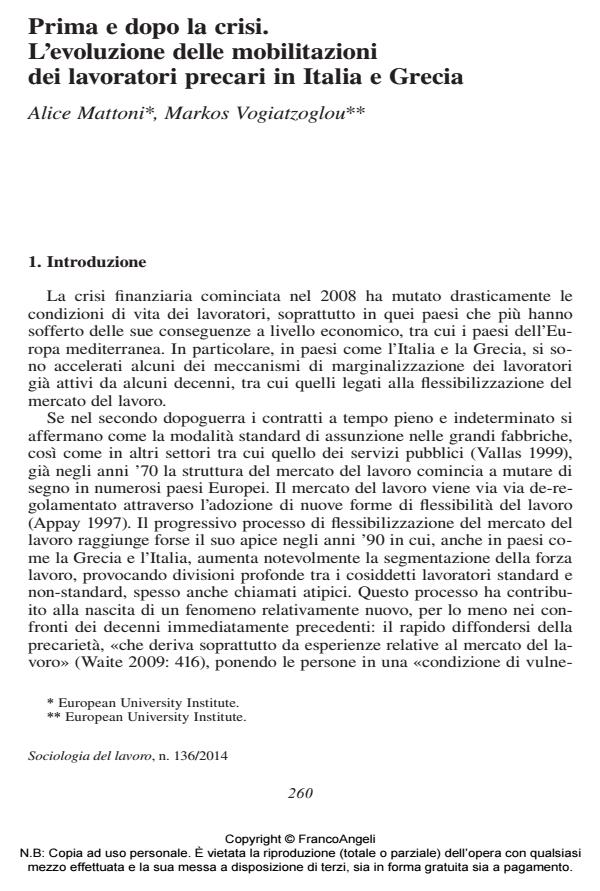Prima e dopo la crisi. L’evoluzione delle mobilitazioni dei lavoratori precari in Italia e Grecia
Titolo Rivista SOCIOLOGIA DEL LAVORO
Autori/Curatori Alice Mattoni, Markos Vogiatzoglou
Anno di pubblicazione 2014 Fascicolo 2014/136
Lingua Italiano Numero pagine 16 P. 260-275 Dimensione file 134 KB
DOI 10.3280/SL2014-136014
Il DOI è il codice a barre della proprietà intellettuale: per saperne di più
clicca qui
Qui sotto puoi vedere in anteprima la prima pagina di questo articolo.
Se questo articolo ti interessa, lo puoi acquistare (e scaricare in formato pdf) seguendo le facili indicazioni per acquistare il download credit. Acquista Download Credits per scaricare questo Articolo in formato PDF

FrancoAngeli è membro della Publishers International Linking Association, Inc (PILA)associazione indipendente e non profit per facilitare (attraverso i servizi tecnologici implementati da CrossRef.org) l’accesso degli studiosi ai contenuti digitali nelle pubblicazioni professionali e scientifiche
Il saggio presenta una comparazione attraverso il tempo e lo spazio delle mobilitazioni dei lavoratori precari, confrontando le lotte contro la precarietà in Italia e in Grecia prima e dopo la crisi finanziaria ed economica. Il saggio parte da una analisi dei cambiamenti che hanno caratterizzato il contesto più ampio in cui si sono sviluppate, negli ultimi anni, le mobilizationi in questione. Si concentra, in seguito, sulle trasformazioni che hanno caratterizzato le lotte dei lavoratori precari prima e dopo la crisi economica nei due paesi. Dall’analisi svolta nelle sezioni del saggio emergono tre punti rilevanti, ripresi anche nelle conclusioni: in primo luogo, il significato che il luogo di lavoro ha per i lavoratori precari e le loro lotte, sempre meno centrale per l’organizzazione delle mobilitazioni; secondo, i cambiamenti nel repertorio della protesta, che si è ampliato andando oltre l’azione collettiva conflittuale soprattutto dopo la crisi finanziaria ed economica; e, infine, il significato che i sindacati tradizionali, i suoi concetti e le sue pratiche, hanno per i lavoratori precari.
Parole chiave:Lavoratori precari, mobilitazione, sindacati, Italia, Grecia, crisi economica
Alice Mattoni, Markos Vogiatzoglou, Prima e dopo la crisi. L’evoluzione delle mobilitazioni dei lavoratori precari in Italia e Grecia in "SOCIOLOGIA DEL LAVORO " 136/2014, pp 260-275, DOI: 10.3280/SL2014-136014